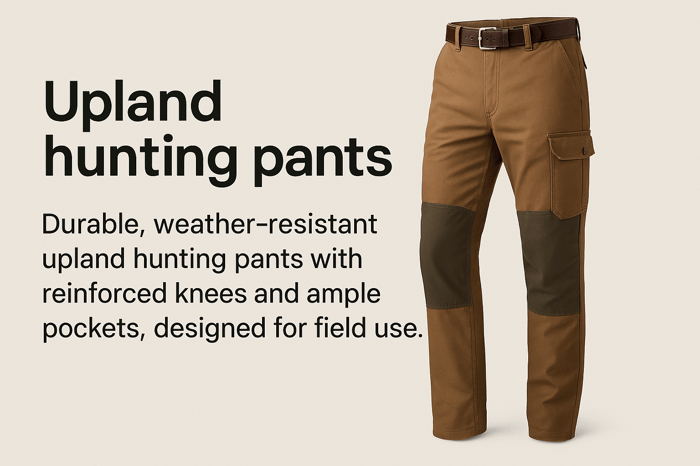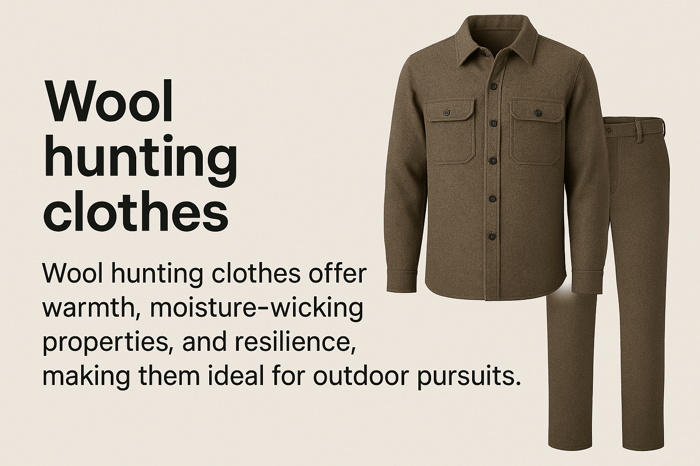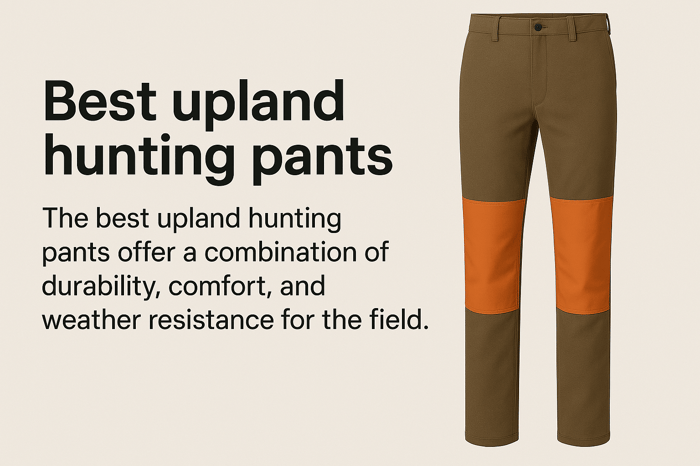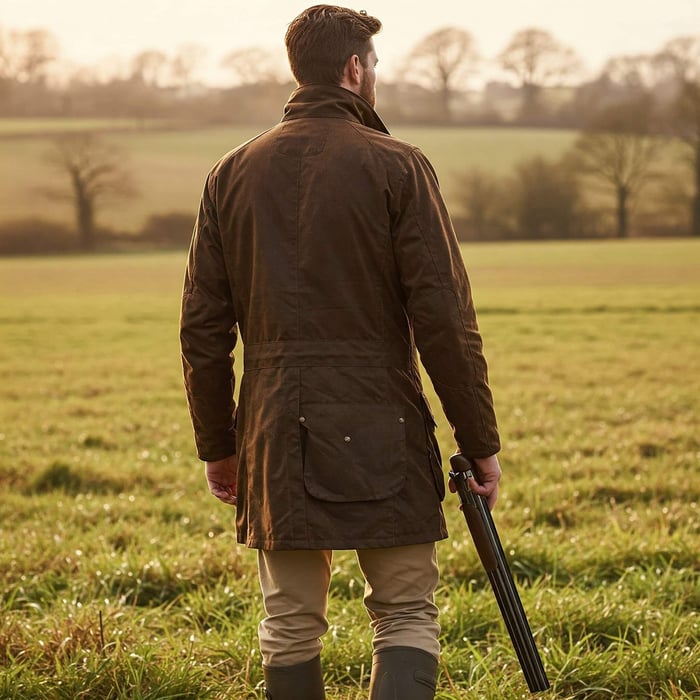When you’re out in the wild, chasing pheasants through tall grass or tracking quail across rocky hills, your gear can make or break the experience. Among the essentials, upland hunting pants are a non-negotiable piece of equipment for any serious hunter. These aren't ordinary pants—they're designed to meet the most extreme terrain, shelter you from weather, and be comfortable on a long day out in the field. In this definitive guide, we'll learn all there is to know about upland hunting pant, including their special attributes, how to select the perfect pair, as well as heaps of tips on how to make sure you're prepared for your next outing.
What Sets Upland Hunting Pants Apart?
If you're a newcomer to upland hunting, you may be curious as to why you can't simply wear a pair of hiking pants or jeans. The fact is, upland hunting pants are made for particular challenges. Upland hunting means fighting through thick cover, tramping through soggy fields, and dealing with finicky weather while remaining mobile and alert. Plain old pants don't possess the durability, mobility, or protection required for such conditions.
Upland hunting pants are designed to endure thorns, mud, and rough terrain without ripping. They tend to feature such things as water-repellent treatments, reinforced knees, and ample pockets for equipment. Whether you're crawling under a barbed wire fence or walking miles to reach a covey of quail, these pants keep you comfortable and safe so you can concentrate on the hunt.
I recall my initial upland hunt wearing an inexpensive pair of cargo pants. They were saturated, ripped, and infested with burrs by noon. When I replaced them with authentic upland hunting pant, I learned how a difference proper gear makes. Let's dissect why these pants differ and why it's worth spending money on them.
Key Characteristics of Upland Hunting Pants
Not all upland hunting pant are the same. To get a pair that will suit your requirements, you must know the most important features that make them work. Here's a closer examination at what to focus on:
Durability for Harsh Terrains
Upland hunting exposes you to some of the toughest terrains around—imagine scratchy briars, rocky terrain, and muddy puddles. Upland hunting pants need to be made from heavy-duty materials like ripstop nylon, canvas, or reinforced polyester. Many brands add double-layered patches on high-wear areas like the knees, shins, or thighs to prevent rips. I’ve seen hunters walk through blackberry thickets with upland hunting pant that came out without a scratch, while lesser pants would’ve been shredded.
Durability isn't merely making it through one hunt—it's pants that withstand season after season. A quality pair can endure years of use, sparing you the hassle of repeatedly replacing lower-quality options.
Weather Resistance for Any Condition
The weather for an upland hunt can change quicker than "point." It's sunny for a minute, and the next you're trying to avoid raindrops or stomping through wet grass. Good upland hunting pants tend to have water-resistant treatments, such as DWR (Durable Water Repellent) coatings, to keep off light rain and moisture. Some even employ breathable waterproof membranes, such as Gore-Tex, for total protection without heating up.
Ventilation is equally critical. Seek out pants with mesh-pocket lining or zippered vents to allow air to circulate, particularly on warmer hunts. I used to wear non-breathable pants on a light fall day, and ended up sweating buckets—never again. The ideal upland hunting pant strike a balance between weather protection and comfort, so you're prepared for whatever.
Comfort and Mobility
Comfort reigns supreme when you're spending hours or even days in the field. Upland hunting pants need to be loose enough to enable you to move about easily, whether you're staying low to avoid scaring game or scrambling over toppled logs. Details such as articulated knees, stretch panels, or gusseted crotches can make a substantial difference in mobility.
Fit matters too. Pants that are too tight restrict your stride, while overly baggy ones can catch on branches or drag in mud. I’ve learned the hard way that trying to “make do” with ill-fitting pants leads to frustration. Modern upland hunting pant often include adjustable waistbands or stretch fabrics to ensure a snug, comfortable fit for all body types.
Practical Storage Solutions
When you’re hunting, you’re carrying more than just enthusiasm. Ammo, a knife, a GPS, snacks, or even a small first-aid kit might be part of your loadout. Upland hunting pant with well-designed pockets keep your essentials secure and easy to reach. Cargo pockets with flaps or zippers prevent items from falling out when you’re scrambling through brush, while smaller pockets are great for things like a whistle or chopstick.
Some pants include specific features, such as knife sheath loops or game bag pouches. Such thoughtful features allow you to quickly access items needed during your hunt, giving you more time for the activity itself rather than scrambling through a pack.
Protection from Hazards
Upland hunting puts you at risk for all kinds of dangers—sharp twigs, biting bugs, even snakes in certain areas. Upland hunting pant frequently have protective features such as reinforced legs, sewn-in gaiters, or insecticide treatments. These protect your skin from cuts, bites, and ticks, particularly in areas where Lyme disease is an issue.
I’ve had close calls with thorns that would’ve torn my legs up if not for sturdy upland hunting pant. Some hunters even opt for snake-proof pants in rattlesnake country, which add an extra layer of peace of mind. Protection doesn’t mean sacrificing comfort—modern materials keep pants lightweight while still offering a strong barrier.
Why Invest in Quality Upland Hunting Pants?
You may be inclined to bypass upland hunting pant and wear whatever you have in your closet. Who needs special pants, after all? Pants are pants, right? Wrong. Though jeans or generic outdoor pants will suffice for a short hike, they will fail you in the demanding terrain of upland hunting.
Upland hunting pant are an investment in your own comfort, safety, and fun. They're designed to get through the unique challenges of the sport, whether it's protecting you from thorns or staying dry during an unexpected shower. Cheap pants will save you money in the short term, perhaps, but it will cost you in the end—whether that's repairing frayed gear or ending a hunt early because you're wet and miserable.
I’ve heard plenty of stories from hunters who learned this lesson the hard way. One friend showed up to a pheasant hunt in regular cargo pants, only to end up with burrs stuck everywhere and a ripped seam by noon. After upgrading to proper upland hunting pants, he couldn’t believe how much easier his hunts became. A quality pair can last years, making them a smart choice for anyone serious about the sport.
Investigating the Best Fabric for Upland Hunting Pants
The fabric of your upland hunting pant is an enormous factor in their performance. Various fabrics provide different advantages, so let's take a look at the most popular options and what sets them apart:
Canvas: The Hard-Working Classic
Canvas has long been the go-to for upland hunting pants, and there's good reason why. It's extremely resilient, able to withstand sharp branches, rough rock, and abrasive brush. Canvas pants are a bit heavier than some newer options, but they soften and break in with use to a warm, comfortable fit that many hunters adore.
The drawback? Canvas is hot in warm weather and takes a while to dry if it becomes wet. Nevertheless, for cold-weather hunts or thickly vegetated areas, canvas upland hunting pant are difficult to surpass.
Ripstop Nylon: Lightweight Strength
For those hunters who value mobility, ripstop nylon is an excellent option. Ripstop nylon is light but durable, with a unique weave that stops small tears from growing. Ripstop upland hunting pants are ideal for hot weather or extended hikes where you must remain nimble.
Nylon also dries quickly, which is a lifesaver if you’re crossing streams or caught in a shower. Some hunters pair ripstop pants with lightweight base layers for added versatility in changing conditions.
Blended Fabrics: The Best of Both Worlds
Most contemporary upland hunting pants employ blended materials, which mix fabrics such as cotton, polyester, and spandex. Blends provide a balance of durability, breathability, and stretch, which makes them versatile for a broad variety of hunts. Cotton provides softness, polyester adds strength, and spandex allows you to move freely.
Blended upland hunting pant are perfect for hunters who would like to have one pair of pants that will get through several seasons. They're also more durable than plain canvas, tending to stand up to the wash well.
Waterproof and Water-Repellent Options
Wet legs are the key to a bad day. That's why most upland hunting pants have water-repellent treatments, such as DWR, to shed light rain and dew. For more severe conditions, some pants include waterproof membranes, such as Gore-Tex or eVent, that keep water out while allowing sweat to escape.
Remember that completely waterproof pants may be more expensive and less breathable, so they're only ideal for rainy climates or late-season hunts. For most upland excursions, water-repellent upland hunting pants are the way to go.
How to Find the Right Fit for Upland Hunting Pant
Fit is paramount when selecting upland hunting pants. A too-tight pair will hamper your movement, and a too-loose one will catch on twigs or be cumbersome. Here's the way to get the perfect fit:
Measure for Accuracy
Begin by taking your waist and inseam measurements. Most clothing companies offer extensive sizing charts, so check your measurements to ensure proper fit. Adjustable waistbands are an ideal feature, allowing you to make small adjustments to the fit, particularly if you're layering for cold weather.
Prioritize Mobility
Upland hunting pant must fit comfortably through the knees and thighs for squatting, climbing, or running after the bird when it is flushed. Articulated knees or stretch panels add flexibility without bulk. I once experimented with pants that seemed great to look at while standing but became shackles on the knees—never again.
Consider Layering
If you're hunting in cold climates, ensure that your trousers allow for space to fit in base layers or thermals. A few upland hunting trousers are made specifically with layering in mind and provide a marginally roomier fit to wear extra clothing without feeling constricting.
Look at the Cuffs
Cuffs are more important than you realize. Loose cuffs can allow dirt, debris, or even ticks to enter, but tight ones help keep your legs safe. Some upland hunting pant have adjustable cuffs or incorporated gaiters to shut out the elements, which is a godsend on muddy or grassy ground.
I've learned to try pants out while moving around—squatting, stepping high, even sitting—to ensure they feel good in use. If you're shopping online, check the reviews for the sizing information.
Taking Care of Your Upland Hunting Pants
In order to get the best performance from your upland hunting pant, careful care is a must. With a bit of work, you can have them functioning like new for many years. Here's how:
Tips for Washing
Always refer to the care label, but most upland hunting pants prefer a cold wash with mild detergent. Never use fabric softeners, which can clog water-repellent coatings and lower performance. If your pants are heavily encrusted with mud, give them a quick rinse before adding them to the machine to avoid clogs.
Drying Wisely
Air-drying is the safest option to preserve the fabric and any special coatings. If you’re in a hurry, use a low-heat setting in the dryer, but avoid high heat, which can damage synthetic fibers or shrink blends. I’ve ruined a pair of pants by cranking the heat too high—lesson learned.
Repairing Damage
Small tears or frayed patches don't doom your pants. Repair tape, iron-on patches, or a needle and thread can repair small damage. Most outdoor companies offer patch kits specific to hunting gear, which integrate well with upland hunting pants.
Storage Solutions
Keep your pants in a dry, cool location to keep them from developing mold or mildew, particularly if they've been worn in damp environments. A mesh gear bag is preferable to a plastic container because it allows air to pass through. Store them clean and completely dry before putting them away to prevent stinky odors or fabric degradation.
I've owned a set of upland hunting pant for almost a decade because I made the effort to clean and put them away. It's not difficult, and it's worth it.
Top Brands Producing Upland Hunting Pants
With so many choices available, selecting a brand can be daunting. Here are some of the top brands in upland hunting pant, recognized for quality and dependability:
Orvis
Orvis is a favorite among hunters who prefer rugged, stylish upland hunting pant. They feature reinforced knees, lots of pockets, and water-repellent treatments. They're not cheap, but the quality is worth it to serious hunters.
Filson
Filson's upland hunting canvas pants are legendary in their ability to last a lifetime. They're rugged, and with a classic design that looks good with any hunting configuration. If you have a thing for gear with stories, Filson's your brand.
Sitka Gear
Sitka incorporates a high-tech strategy, with stretch and weather-resistant advanced fabrics. Their upland hunting pants are light yet full of details such as vented pockets and articulated knees that are ideal for active hunters.
Cabela's
For affordable hunters, Cabela's presents good upland hunting pant without cutting corners on the basics. They're good for beginners or anyone who wishes to have trusty gear at an affordable cost.
Beretta
Beretta combines European flair with functional design. Their upland hunting pants tend to have clean lines and well-considered details, such as game-bag pockets, that appeal to discerning hunters.
All brands suit varying tastes, so experiment with several to determine what fits your style, budget, and hunting patterns.
Seasonal Considerations for Upland Hunting Pants
Upland hunting goes across several seasons, and weather can significantly impact your gear options. Here's how to select upland hunting pant for each season of the year:
Spring and Summer
Early-season hunts may be warm and buggy. Light upland hunting pants constructed of ripstop nylon or cotton-blend material are best, providing breathability and fast-drying capabilities. Insect repellent treatment is a necessity in tick- or mosquito-infested regions. Choose pants with mesh vents for staying cool on lengthy walks.
Fall
Fall is peak upland season, with cold mornings and mild afternoons. Water-repellent-coated mid-weight upland hunting pant perform nicely, coping with dew-covered fields and light rain. A loose fit with space for light layering allows you to stay warm when temperatures vary.
Winter
Late-season hunts bring cold, wet, or snowy conditions. Insulated or fleece-lined upland hunting pants provide warmth without sacrificing mobility. Pair them with waterproof boots and gaiters to stay dry in slushy fields. For extreme cold, consider pants with windproof layers to cut through biting gusts.
I've learned my lesson about wearing thick pants during a hot October hunt, and let me assure you—sweating buckets isn't pleasant. Now I always look at the weather forecast and select my upland hunting pants based on the season.
Accessories to Pair with Upland Hunting Pants
Your upland hunting pant are only one part of the equation. To create an entire hunting system, take a look at these accessories:
Hunting Boots
Waterproof, supportive boots with aggressive treads are essential for navigating uneven terrain. Look for mid-calf or higher boots to pair with your upland hunting pants’ gaiters or cuffs for maximum protection.
Belt
A sturdy belt keeps your pants secure, especially if you’re carrying heavy gear in your pockets. Nylon or leather belts with quick-release buckles are popular for their durability and ease of use.
Game Vest
A shell-storing, water-and-game-capable hunting vest supplements your pant storage. Get one with straps that can be adjusted to comfortably layer over your upland hunting pants.
Gloves
Lightweight, textured gloves help defend your hands from thorns and enhance your grip on your shotgun. A few hunters find fingerless gloves offer improved trigger control.
Base Layers
During cold weather, moisture-wicking base layers beneath your upland hunting pant keep you dry and warm. Merino wool or synthetic blends are excellent for temperature regulation.
These add-ons complement each other to make you more comfortable and efficient, allowing you to concentrate on the hunt.
Where to Buy Upland Hunting Pants
Ready to get a pair of upland hunting pants? Here are the best places to shop:
Outdoor Retailers
Big-box retailers such as Bass Pro Shops, Cabela's, or REI stock many different upland hunting pant , frequently having personnel who can provide recommendations. You can try them on to guarantee a proper fit.
Online Stores
Amazon, Orvis, or Sitka Gear's website offer comprehensive sizing charts, customer feedback, and in some cases, special discounts. Online shopping excels at comparisons and bargain hunting.
Local Outfitters
Small hunting stores tend to carry high-quality upland hunting pants and offer personalized service. The personnel typically know what they're doing and can make recommendations based on your local topography.
Secondhand Options
Budget hunters, look to thrift stores, consignment stores, or online sources such as eBay for used upland hunting pants. Just check them for wear and tear before purchasing.
Watch for sales during hunting season or holidays—stores tend to drop prices on equipment, so it's a good time to find a bargain.
Common Mistakes to Avoid When Buying Upland Hunting Pants
Even seasoned hunters can get things wrong when selecting upland hunting pants. Here are some traps to avoid:
Skimping on Quality
It's easy to opt for the lowest price, but cheap pants will not hold up. Spending money on high-quality upland hunting pants pays off in the long run and saves you hassle.
Neglecting Fit
Pants that fit poorly—too tight or too loose—will destroy your hunt. Always refer to sizing charts or test them on to ensure comfort and ease of movement.
Overlooking Weather Needs
Buying heavy pants for warm climates or lightweight ones for winter hunts is a recipe for discomfort. Match your upland hunting pants to the conditions you’ll face.
Forgetting About Maintenance
Some pants require special care to maintain their water-repellent or durable properties. Read the care instructions before buying to make sure you’re up for the upkeep.
I used to purchase pants without trying on, assuming "good enough" was good. Terrible error—the pants were so tight that I could hardly get down on one knee. Do yourself a favor and get it right the first time.
Instructions for Breaking in Your Upland Hunting Pants
Fresh upland hunting pants may initially be stiff, particularly if made from canvas or thick materials. Breaking them in properly will get them comfortable fast:
Wear Them Around: Wear them around the house or take short walks to allow the fabric to relax naturally.
Move Actively: Take a few squats, lunges, or high steps to extend important areas such as the knees and thighs.
Wash First: Soften the material by a gentle wash, but be sure to adhere to care instructions to prevent damaging coatings.
Wear them lightly: Use them on a short hunt or scouting excursion prior to a major hunt to see how they shoot.
My experience has shown that the proper break-in of upland hunting pants breaks them in like a second skin, instilling confidence in the field.
The Future of Upland Hunting Pants
As technology gets better, upland hunting pants are becoming wiser and multi-functional. Brands are trying to use environmentally-friendly materials, such as recycled polyester, to mitigate environmental effects. Others are putting in technology-powered features, such as moisture-sensitive or built-in GPS pockets to hold navigation systems.
Even some manufacturers are creating modular pants with removable liners or zip-off legs, allowing hunters to adjust to unpredictable weather conditions on the fly. All these new innovations notwithstanding, at their heart, upland hunting pants are still all about durability, comfort, and protection for the unforgiving outdoors.
Final Thoughts on Upland Hunting Pants
When you're doing upland hunting, your equipment is your survival. Upland hunting pants may be the smallest thing to consider, but they are the biggest factor in keeping you dry, safe, and on your game. From avoiding thorns to remaining dry in a light rain, a good pair of pants can make a good hunt an excellent hunt.
By selecting upland hunting pants with the features, fit, and materials that suit your requirements, you're investing in decades of adventures. Invest the time to look after them, match them with the correct accessories, and get them properly broken in, and they'll pay you back with lasting performance. Whether you're an experienced hunter or a beginner, don't underestimate the power of high-quality gear. Go out there, get your ideal upland hunting pants, and make every hunt a memorable one.





